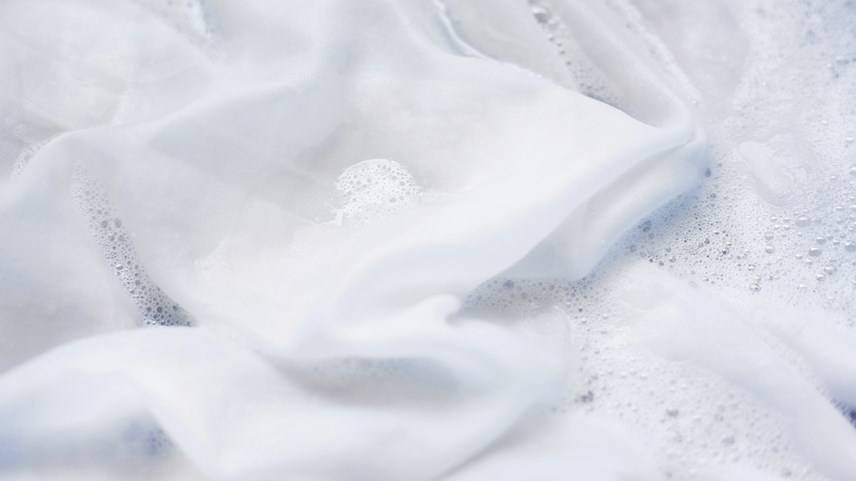The best way to wash your clothes in a washing machine
Follow along to discover key steps for how to use a washing machine. You’ll find out how to select the right wash temperature, wash cycle and where to put in your detergent and softener for optimal cleaning. You’ll also learn how to wash clothes by hand and how to remove most stains.

How to do laundry: a step-by-step guide
1. Separate your laundry

2. Load your washing machine
A small load represents ⅓ of the machine drum.
A medium load is roughly ½ of the capacity of the machine drum.
A large load is about ⅔ capacity of the machine drum.
Even if you decide to wash a large load, you still need to be able to fit your hand in the machine. If you can’t, then you know the machine is too full!
3. Add detergent and fabric softener
It’s important for cleanliness and for the longevity of your clothes to know where to put detergent in the washing machine. You need to check the product label on the detergent packaging to know how to dose the correct amount of powder or liquid detergent.
Learn what the detergent drawer symbols mean.

The bigger compartment marked as “II” is where you put detergent in your washing machine for main washes and Vanish Oxi Action.
The part of the detergent drawer marked with a flower symbol is where you put the fabric softener.

4. Select the correct washing cycle
Cleaning method
High agitation wash
High-speed spin cycle
Adjustable temperature
Clothing type
Sheets, towels, whites, heavily-soiled items, cotton underwear and socks.
Cleaning method
Medium agitation wash
Medium-speed spin cycle
Warm-to-cool temperature
Clothing type
Synthetic garments with medium soiling: blended and synthetic fabrics, polyester, jeans and jumpers.
DELICATES
Cleaning method
Low agitation wash
Low-speed spin cycle
Clothing type
Delicate garments such as lingerie, silk, wool, knits and other delicate fabrics.
HAND-WASH
Cleaning method
Low agitation wash
Low-speed spin cycle
Clothing type
Very delicate garments with the hand-wash icon on the care label.

5. Select the correct water temperature
What temperature is a cold wash? 30°C and lower is a cold wash and it’s a high enough temperature for delicate fabrics, bright colours that could run or fade. To ensure maximum longevity of your clothes, wash clothes at 20°C using Vanish Oxi Action Multi Power powder for colours and Vanish Oxi Action Crystal White powder for whites with laundry detergent to remove even the toughest of stains.
What temperature is a warm / hot wash? 40°C is a warm wash and is the most common temperature and 60°C is considered hot.
6. Turn on the washing machine
After the wash cycle is complete, make sure you leave the door slightly open to avoid mould or mildew buildup which could make your machine – and clothing – smell.
7. Dry your clothes
Air drying: The pros of that drying method include cost savings, both on the initial equipment and your energy bill later, as well as a reduced risk of damaging or shrinking your clothes. However, it takes more time and space, especially in colder and more humid weather.
Tumble drying: That method can be more convenient and efficient, as you can dry your laundry immediately, regardless of the weather. A washer-dryer will also require less maintenance as the drying cycle starts as soon as the wash ends. However, repeatedly tumble drying your clothes can shorten their lifespan.

8. Clean your washing machine
Not only do you need to leave the door open, but you also need to clean your washing machine regularly in order to keep it smell-free and in working condition for longer! This will also ensure clean laundry, wash cycle after wash cycle. Hard water is common especially in the southern half of the United Kingdom, and regular upkeep will prevent buildup. A washing machine could require cleaning 2 or 3 of times a year. You can easily do so by adding a washing machine cleaner product to an empty load and running a complete wash cycle.
Not sure how to clean the washing machine rubber? After you’ve run a machine-cleaning cycle, simply make sure you wipe clean the seals!
Common mistakes to avoid when doing laundry
Don’t put liquid fabric softener directly on laundry: Softener goes into the detergent drawer of the washing machine. Applying it directly to the garments may stain them.
Don’t leave anything in the pockets of your clothes: Before you load the washing machine, be sure to check all pockets! A pen could stain your clothes with ink, and even a piece of paper could result in fluff sticking to your laundry.
Don’t mix dark and white colours: Be sure to separate your laundry before you wash it, as mixing colours could result in dark fabrics fading and white ones greying.
Don’t leave wet clothes in the washing machine for too long: If your washing machine doesn’t make a sound when the cycle is over, consider setting a timer. Wet laundry will start smelling if left in the washing machine too long.
Don’t overload the washing machine: Your laundry won’t be properly cleaned if you try and load too many garments in the washing machine at once. In the long run, it may also damage your machine if you overload it constantly.
Don’t mix up the fabric softener and detergent compartments: The washing machine drawer has separate compartments with icons to indicate where detergent & Vanish and where fabric softener goes – this ensures that the right product is dispensed at the right time during a wash cycle.
The first icon is generally a bucket filled with water including the water temperature.
A hand in the water represents advised hand-washing (you can select the hand-wash cycle or actually hand-wash your items in the sink).
The triangle helps you understand whether or not you can use bleach.
A crossed-out triangle means no bleaching is allowed.
Diagonal lines fill the triangle for non-chlorine bleach.
A plain triangle is for regular bleaching.
The square represents drying advice to care for your garment.
A square with a circle inside means tumble drying is allowed.
An additional dot inside means tumble drying at a low temperature.
Multiple dots mean high-temperature tumble drying is advised.
A crossed-out circle in a square indicates no tumble drying.
A square with three vertical lines inside is for drip drying.
A single horizontal line in the middle indicates flat drying.
A drooping line on top means hang to dry.
Ironing advice is represented by a simplified iron icon.
A single dot inside for a cool iron (max 110 °C).
Two dots for medium iron (max 150 °C).
Three dots for a hot iron (max 200 °C).
If it’s crossed out, avoid ironing.
Dry cleaning symbols
The presence of a circle on the care label indicates how to approach professional dry cleaning.
A regular circle means dry cleaning only.
Letters in the circle will help your dry cleaner select the right solvent: A for any solvent, P is any solvent except for trichloroethylene, and F is for petroleum solvent only.
A crossed-out circle means do not dry clean.
How to treat stains
- You need to identify the origin of the stain: coffee, fruit or oil stains will usually require different products.
- If you’re using Vanish powder stain remover, you need to mix it with water and let the garment soak for 60 minutes before you put the garment in the washing machine.
- If you’re treating a localised stain, you might want to rub the stain remover into the stain for more effective removal. You will need to leave it on for 5-10 minutes as well before washing the garment in the machine.

How to hand-wash clothes
– Identify stains and treat them with Vanish powder stain remover first.
– Select the water temperature: room temperature works for most hand-washing, but make sure you check the care label first.
– Mix your hand-wash laundry detergent with water and let the garments soak into the mix for at least 30 minutes.
– Empty the soiled water and refill the sink with cool water to rinse your clothes. Stir the garments and take them out.
– Avoid wringing wet clothes as it can damage the fabric, instead press them onto the side of the sink to get rid of excess water and lay your clothes to dry.
